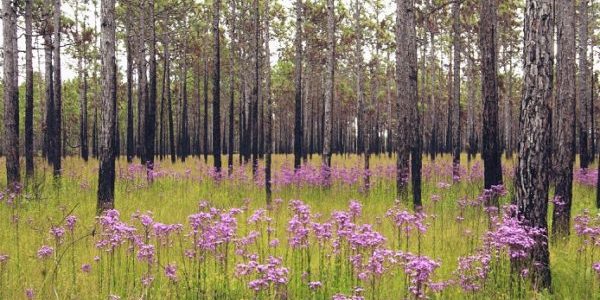Native Longleaf Pine Forests

Native longleaf pine forests
Longleaf pine is a native evergreen conifer in the southeastern United States. Its range stretches from Virginia down the Atlantic coast states and to the gulf coast of Texas. The longleaf pine ecosystem’s historical reach spanned over 91 million acres of southeastern states. Additionally, the loss of much of the overall longleaf pine ecosystem has led to a decrease in abundance of nearly 200 associated plant species. Fire is important to the life cycle of longleaf pines as the seeds need direct contact with soil to germinate. Historically, lightning-caused fires along with fires set by Native Americans and early settlers were responsible for clearing the understory and maintaining the open savanna-like ecosystems. Without fire, these landscapes are invaded by hardwoods and other pines that crowd longleaf regeneration and increase fuel loads. Along with anecdotal data, long-term studies have shown that the frequent use of fire stimulates the growth and development of longleaf pines and the diverse understory.
A closer look: understory diversity
The need to protect and restore longleaf pine is well known, but the importance of the forest understory has gotten less attention. Healthy, well-managed longleaf systems have canopies dominated by longleaf pine, an open mid-story, and an extremely diverse understory, whose richness per unit area is rivaled only by the tropics and whose constituents can be as long-lived as the trees growing above them. Groundcover in longleaf systems consist of wildflowers, bunch grasses, and the occasional low-lying carnivorous plant. Additionally, a healthy, diverse herbaceous understory serves as fuel that carries fire consistently across a site, thus facilitating good fire in longleaf pines stands – a necessary tool for long term restoration of this fire adapted ecosystem.
Montane longleaf
Montane longleaf forests are distinct from its other habitat types as they are adapted to well-drained sandy to rocky soils on mountain slopes and ridges. Primarily longleaf pine-dominated forests are open-canopied and uneven-aged; these uneven-aged stands consist of variably sized patches that were the result of frequent small-scale disturbances. These openings were created by windstorms, fires, fatal insect infestations, and occasional ice storms.
Further reading
Barnett, James. 2000. “Longleaf Pine Ecosystem Restoration: The Role of Fire.” Journal of Sustainable Forestry 9.
Brockway, D. G., & Outcalt, K. W. (2015). "Influence of selection systems and shelterwood methods on understory plant communities of longleaf pine forests in flatwoods and uplands." Forest Ecology and Management, 357, 138–150. https://doi.org/10.1016/j.foreco.2015.08.020
Brockway, D.G., Outcalt, K.W., 2000. "Restoring longleaf pine wiregrass ecosystems: hexazinone application enhances effects of prescribed fire." Forest Ecology and Management, 137, 121–138. https://www.fs.usda.gov/treesearch/pubs/2311
J. Morgan Varner, III, John S. Kush, and Ralph S. Meldahl. 2003. “Structural Characteristics of Frequently-Burned Old-Growth Longleaf Pine Stands in the Mountains of Alabama.” Castanea 68(3): 211–21.
Klaus, N., Isler, A., & Klaus, J. (2014). Is your site prep helping or hurting your longleaf pine restoration? Using herbicides to restore the longleaf pine ecosystem.
Self, A. Brady. 2019. Herbicide Options for Management of Longleaf Pine. Publication 3405.
Stokes, T. A., et al. 2010. "Structure and Diversity of Longleaf Pine (Pinus palustris Mill.) Forest Communities in the Mountain Longleaf National Wildlife Refuge, Northeastern Alabama." Natural Areas J., 30(2):211-225. https://doi.org/10.3375/043.030.0208.
Varner, J. Morgan, and John S. Kush. 2004. “Remnant Old-Growth Longleaf Pine (Pinus Palustris Mill.) Savannas and Forests of the Southeastern USA: Status and Threats.” Natural Areas Journal 24(2): 141–49.
Stay Informed
about our recent projects and upcoming events.
